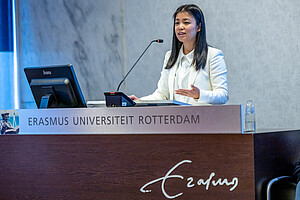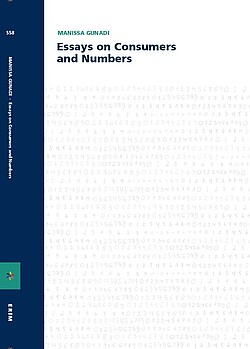PhD Defence Manissa Gunadi

In her dissertation, Essays on Consumers and Numbers, Manissa Gunadi shed light on customer interpretation of numeric information. Her research built on consumer behaviourism starting with the consumers interpretation of historic price data. The next perception Manissa discovered is the tendency for consumers to exacerbate numeric values that have come from a more frequently updated source, showing a consumer’s preconception to frequency of information. She rounded her dissertation with evaluating the perception of numeric information within task instruction.
Manissa successfully defended her dissertation on Thursday, 15 December 2022. Her supervisors were Prof. Stefano Puntoni (The Wharton School) and Dr. Bram Van den Bergh (RSM). Members of her doctoral committee were Prof. Ale Smidts (RSM), Dr. Inga Hoever (RSM), Dr. Gabriele Paolacci (RSM), Prof. Irene Scopelliti (Bayes Business School), and Prof. Simona Botti (London Business School).
About Manissa Gunadi

Manissa Gunadi was born in Jakarta, Indonesia on August 14th, 1991. Manissa obtained her BSc degree in Economics from Erasmus School of Economics, Erasmus University (2012) and MSc degree in Marketing Management from Rotterdam School of Management, Erasmus University (2013). Prior to starting as a PhD candidate, she also completed the two-year MSc in Business Research program (with a specialization in Marketing) at Erasmus Research Institute of Management (2015). As part of her PhD trajectory, Manissa was a Visiting Graduate Researcher at Anderson School of Management, University of California, Los Angeles in the Fall of 2017. Following her doctoral studies, in 2019, Manissa worked as a Post-Doctoral Researcher in Marketing at ESADE Business School, Barcelona, Spain. She currently works as Assistant Professor at the Department of Marketing, Operations and Supply at EADA Business School, Barcelona, Spain.
In her research, Manissa primarily investigates how different forms of numerical information influence consumers’ judgments, decision-making, and behavior. Additionally, she is also interested in examining drivers of consumer motivation. Her work has been published in the Journal of Marketing Research and Journal of the Association of Consumer Research. She has presented her work at various international conferences (e.g., Society of Judgment and Decision Making, Association for Consumer Research, Theory and Practice in Marketing Conference, Subjective Probability, Utility and Decision Making, and European Marketing Academy). Her personal interests include cooking and food culture, traveling, reading, and long-distance running.
Thesis Abstract

This dissertation focuses on the relationship that consumers have with different forms of numerical information. Numbers can be considered as a universal language. They are used to quantify a host of attributes within the consumer environment, and they often serve as important cues for decisions that consumers make across different facets of their lives. This dissertation aims to show that the consumers’ relationship with numbers is in fact complex and nuanced—it cannot solely be viewed from a normative, mathematical perspective. That is, while numbers inherently hold objective value and meaning, admittedly subjective perceptions may frequently prevail. Relatedly, interpretation of numerical information is also largely malleable, in that a variety of different factors may distort how numerical figures may be perceived.
The first chapter focuses on numerical information in the form of historical prices. Upon observing historic price information, while controlling for absolute magnitude of changes, consumers’ decision to make or defer purchase crucially depends on the interaction between the frequency and direction of observed changes. The second chapter focuses on numerical information that is dynamic in nature. It is found that consumers tend to perceive an identical numerical value as larger when it stems from a more frequently updated source, versus less frequent. The third chapter focuses on numerical information that is embedded within task instructions, specifically whether they are framed as expected output versus input. Constructing task instructions in terms of expected output leads to greater motivation during a task, compared to using input-based framing.
View photos of Manissa's PhD Defence
Photos: Chris Gorzeman / Capital Images


